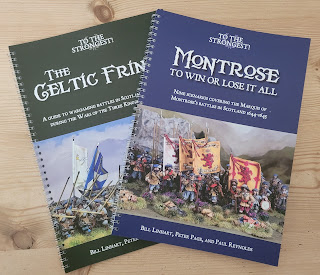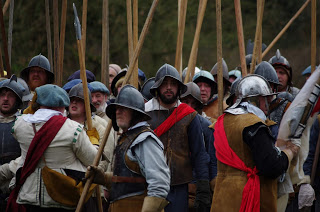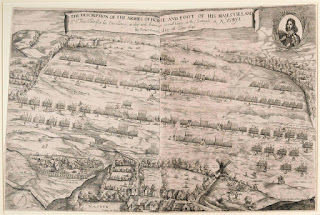Leicester
The ECWtravelogue finally gets around to visiting Leicester, well known home of malcontents who like to bury royalty in car parks.
Leicester was a Parliamentarian stronghold pretty much untroubled by the King until the dying days of the First Civil War; that is not to stay nothing happened here, there were a number of skirmishes between the opposing forces around the Thurcaston Road bridge and inside St Peter's Church; but it wasn't until May 1645, when the King's Army attacked the town (to draw the threat of the Army Newly Modelled away from Charles's capital of Oxford) that Leicester saw significant fighting.
Rupert deployed his artillery outside the town, prior to demanding that the garrison surrender. The garrison rebutted Rupert's request and the assault began at 3pm on 30 May 1645.
The medieval walls had mostly been dismantled, with only short sections remaining. The town had not established extensive earthwork fortifications, only starting to develop defensive structures early May 1645.
The Royalist assault began at Newarke gatehouse, where they quickly breached the defenses. Prince Rupert started the attack possibly a little too early, meeting stiff defence from the garrison. The assault was a three pronged attack Rupert attacked from the south (Newarke gate area); Colonel George Lisle attacked from the north down North Gate Street; and Northampton and Bard attacked the Belgrave Gate/ Humberstone Gate area. After fierce fighting, with such overwhelming numbers on the attacker's side, the town fell.
 |
| The Magazine Gateway aka Newarke Gateway |
Leicester was a Parliamentarian stronghold pretty much untroubled by the King until the dying days of the First Civil War; that is not to stay nothing happened here, there were a number of skirmishes between the opposing forces around the Thurcaston Road bridge and inside St Peter's Church; but it wasn't until May 1645, when the King's Army attacked the town (to draw the threat of the Army Newly Modelled away from Charles's capital of Oxford) that Leicester saw significant fighting.
 |
| The Guildhall |
Rupert deployed his artillery outside the town, prior to demanding that the garrison surrender. The garrison rebutted Rupert's request and the assault began at 3pm on 30 May 1645.
The garrison normally consisted of four companies of foot under the command of Colonel Theophilus Grey, and about 200 horse under Sir Edward Hartopp. There were also about 400 residents who were armed and enlisted into the defence.
At the time of the assault, the garrison was bolstered by Sir Robert Pye's Regiment of Horse, part of a brigade detached from Fairfax's main force to shadow the King's progress from Oxford, and 200 dragoons from Newport Pagnell under Major James Innes, who were en route to Nottingham. The Royalist force numbered between 8 and 10000 men; the King was amongst their number, but this was a Rupert command.
The medieval walls had mostly been dismantled, with only short sections remaining. The town had not established extensive earthwork fortifications, only starting to develop defensive structures early May 1645.
The Royalist assault began at Newarke gatehouse, where they quickly breached the defenses. Prince Rupert started the attack possibly a little too early, meeting stiff defence from the garrison. The assault was a three pronged attack Rupert attacked from the south (Newarke gate area); Colonel George Lisle attacked from the north down North Gate Street; and Northampton and Bard attacked the Belgrave Gate/ Humberstone Gate area. After fierce fighting, with such overwhelming numbers on the attacker's side, the town fell.
Mercurius Aulicus reported 80 Royalist dead and 120 Parliamentarian. The pro-Parliamentarian A Perfect Relation, put the number of dead higher, at 300.
What happened next is debatable. Rupert's men sacked the town, unrestrained by the King or Prince Rupert. Claims of 700 inhabitants and defenders being massacred may well have been a fabrication by Parliamentarian news sheets to bolster their cause. Regardless, the reports had the desired effect.
Charles would meet Fairfax's main force at nearby Naseby a month later. After Naseby, Leicester was recovered by Parliament on 18th June 1645.
What's there now?
Close by is Turret/Prince Rupert Gateway, the remains of a medieval gateway strangely renamed in honour of the man who led the alleged sacking of the town. There was once a two-storey house on top of the gateway. The house was badly damaged during the 1645 siege, and more seriously damaged during election riots in the late C18th.
Whilst in the Newarke area it is worth visiting the The Newarke Houses Museum, some original features are on view, but most notably original glass panels from Wygston's House are on display.
Cavendish House, was built in the grounds of Leicester Abbey. When the Abbey was dissolved, the building materials were reused in various structures across Leicester, including a mansion which was built on the site. The house passed through several aristocratic families, and became known as Cavendish House after it was acquired by the 1st Earl of Devonshire, in 1613. The house was eventually looted and destroyed by fire in 1645, following the capture of Leicester during the English Civil War.
Postcodes for SatNavs
Thurcaston Road Bridge, Thurcaston Road LE4 5PF
Church of St Peter, Church Road, Belgrave LE4 5PE
Raw Dykes Aylestone Road LE2 7JU
Newarke Gate, The Magazine, Vaughan Way LE1 5XZ
Medieval walls, The Newarke LE2 7BY
Turret/Prince Rupert Gateway, Castle View LE1 5WH
Charles would meet Fairfax's main force at nearby Naseby a month later. After Naseby, Leicester was recovered by Parliament on 18th June 1645.
What's there now?
As you can imagine Leicester has a lot of history on display; the discovery of Richard III's body has, naturally, led to an increase in Richard III tourism, which Leicester has catered for. As a result there is little else of Leicester 's history on display. Leicester Museum Service has a considerable collection of artefacts from Naseby, in their store. At the time of the KeepYourPowderDry visit there were no C17th artefacts on display in any of the Leicester museums.
The fifteenth century Thurcaston Road Bridge and nearby Church of St Peter are located to the north of the modern city. Please note: Thurcaston bridge is a bus gate, don't try and drive over it. If you are driving around visiting these sites, it is best to drive to St Peter's, and approach the bridge from the eastern side.
 |
| The Raw Dykes |
Raw Dykes are possible Roman earthworks, believed to have been utilised by Rupert to deploy his artillery, which bombarded Newarke Gate. Sited next to a busy main road, parking is understandably difficult. I was able to find on street parking close to the gas museum on Boundary Road.
 |
Newarke Gate is now called the Magazine, as it is believed that powder was stored here by the Parliamentarian garrison.
 |
 |
| Turret Gateway aka Prince Rupert Gateway |
Close by is Turret/Prince Rupert Gateway, the remains of a medieval gateway strangely renamed in honour of the man who led the alleged sacking of the town. There was once a two-storey house on top of the gateway. The house was badly damaged during the 1645 siege, and more seriously damaged during election riots in the late C18th.
 |
| St Mary de Castro |
Behind the gateway is the C12th St Mary de Castro church; the outside does not appear to show any scars from the fighting. The churchyard does afford excellent access to the remaining stretch of the town walls (complete with musket loops).
 |
| The Castle business school building |
Just up the hill, opposite St Mary de Castro is the site of the castle. Now part of Leicester Uni's business school, it opens occasionally to the public.
 |
| Newarke Houses Museum |
Whilst in the Newarke area it is worth visiting the The Newarke Houses Museum, some original features are on view, but most notably original glass panels from Wygston's House are on display.
 |
 |
| Wygston's House |
C15th Wygston's House is a beautifully preserved timber framed house that will have born witness to the siege. It is now a bar and restaurant, several artefacts from the house are on display at the Newarke Hosues Museum.
A little further down Applegate is the C16th Old Grammar School building, predating the Wars it too would have borne witness to the events.
 |
| The Great Hall, the Guildhall Museum |
The C14th Guildhall Museum; many negotiations between Crown and the Corporation of Leicester took place here prior to the sacking of Leicester. When Rupert's men entered the town they looted the Guildhall, taking the town's archives, as well as the mace and seal.
 |
| Cavendish Hall |
Cavendish House, was built in the grounds of Leicester Abbey. When the Abbey was dissolved, the building materials were reused in various structures across Leicester, including a mansion which was built on the site. The house passed through several aristocratic families, and became known as Cavendish House after it was acquired by the 1st Earl of Devonshire, in 1613. The house was eventually looted and destroyed by fire in 1645, following the capture of Leicester during the English Civil War.
 |
Charles I is reputed to have stayed in the house immediately after the sack of the town, which seems unlikely seeing as it was supposedly set on fire during the looting.
 |
| Strange architectural feature or musket loops? |
The remains of the Abbey walls appear to have musket loops (most noticeable on the river side).
 |
Conduit Street was the site of a lead channel built in 1645, this was effectively a water main taking fresh water from St Margaret's Fields to the market area of the town. A plaque marks its existence.
Postcodes for SatNavs
Thurcaston Road Bridge, Thurcaston Road LE4 5PF
Church of St Peter, Church Road, Belgrave LE4 5PE
Raw Dykes Aylestone Road LE2 7JU
Newarke Gate, The Magazine, Vaughan Way LE1 5XZ
Medieval walls, The Newarke LE2 7BY
Turret/Prince Rupert Gateway, Castle View LE1 5WH
St Mary de Castro church, Castle View LE1 5WH
Leicester Castle, 7 Castle View LE1 5WH
The Newarke Houses Museum, The Newarke LE2 7BY
Leicester Castle, 7 Castle View LE1 5WH
The Newarke Houses Museum, The Newarke LE2 7BY
Wygston's House, 12 Applegate LE1 5LD
The Old Grammar School, 1573 Bar & Grill, 41 Freeschool Lane LE1 4FY
The Guildhall Museum, Guildhall Lane LE1 5FQ
Parking for Newarke area LE2 7LQ
Cavendish House, Abbey Park LE4 5AQ
Cavendish House, Abbey Park LE4 5AQ
Abbey Park car park, Abbey Park Road LE4 5AQ
Conduit Street LE2 0JN
If you enjoyed reading this, or any of the other posts, please consider supporting the blog.
Thanks.














Wonderful buildings- really inspirational for someone like me who enjoys building terrain.
ReplyDeleteVery interesting. Great photos.
ReplyDeleteHi, any more details about the skirmish at Thurcaston Bridge please.
DeleteAlas, with most small scale clashes little is recorded other than it happened. A memorial in the church appears to have shot damage.
DeleteOther than that the only real specifics I have found are that Hastings' men were driven from the bridge on 10th August 1644.
Many thanks, that could make a good wargame scenario.
Delete